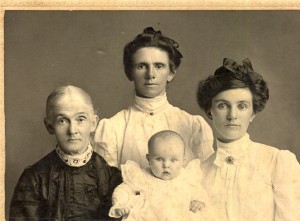
Four generations, MS-92 Wallace Family Papers, Special Collections and Archives, Wright State University Libraries
The theme of the 2012 National Women’s History Month is Women’s Education – Women’s Empowerment. One way to learn more about women’s role in history is to seek out primary sources created by women as a way of discovering women’s work and life. Oftentimes the role of women was that of the family caretaker, so a great place to discover women in history is to look to family history collections for materials. Letters and diaries, photographs, momentos, and oral histories are terrific ways to discover women in their own words and images throughout different historical periods. Even recipe books, postcards, and scrapbooks can offer a tremendous amount of information about the women who used these items.
One of the best examples of a collection containing a variety of primary source materials concerning women is from our family collections, MS-92, the Wallace Family Papers. The Wallace Family Papers are an extensive collection of document, correspondence, and photographs which provide the history of a farming family in Ohio over a period of more than two hundred years, covering more than five generations of family history. It is to the family’s credit that such a remarkable amount of history has been recorded and preserved for so many generations.
The family records begin in the early 1800s, when Reuben Wallace became the first generation of the Wallace family to settle in Clark County. The land he lived on is still in the Wallace family. Throughout each successive generation, the letters, diaries, and photographs trace the family’s lives. The Wallace women were schoolteachers, farm wives, and genealogists. Some traveled a lot, while some rarely left the Clark County area. But the bits and pieces of their lives that have been preserved document their struggles and their joys and create a remarkable picture of two hundred years of women’s lives in the Miami Valley region.
A couple of items of note include a marvelous autograph/memory album belonging to Anna Barr Wallace. Anne left her home in Indiana in the early 1850s to marry into the Wallace family in Ohio. This album contains original poetry and kind remembrances from her friends and family, wishing her well as she set off to begin her new life. Another charming set of items centers on Anna’s daughter and granddaughter. A family photograph album shows an adorable granddaughter, named Anna for her grandmother, between the ages of about three and seven or so, most often shown with her parents or little sister. In part of the correspondence is a letter she wrote, in adorable childish scrawl, to her father, asking him to please bring her some gum on his return, as she lost her gum when she put it under her dinner plate.
The account books and financial papers often show the influence many Wallace women had on the family finances, including their household account books in some cases. The years of correspondence track relationships between mothers and children, especially as children grew up and traveled for school or employment. The photographs show the passing of the years, the landscapes in which they lived, the family members they loved.
What emerges from these records is the story of many generations of women’s lives and how those lives reflect the times in which they lived. Events of national historical significance –the Civil War, World War I and II, the Vietnam conflict, and the Great Depression– are brought home to the Wallace farm in Ohio. Events of daily life are played out generation after generation.
Discovering women’s history in family collections is not without its challenges. But oftentimes the material discovered makes the hunt worthwhile.
See what kind of treasures you might be able to find by exploring some of our other family collections.
